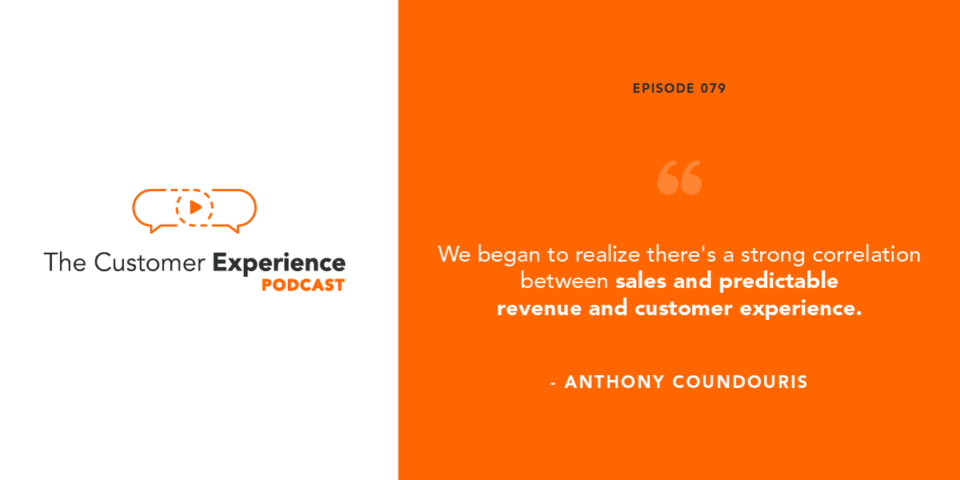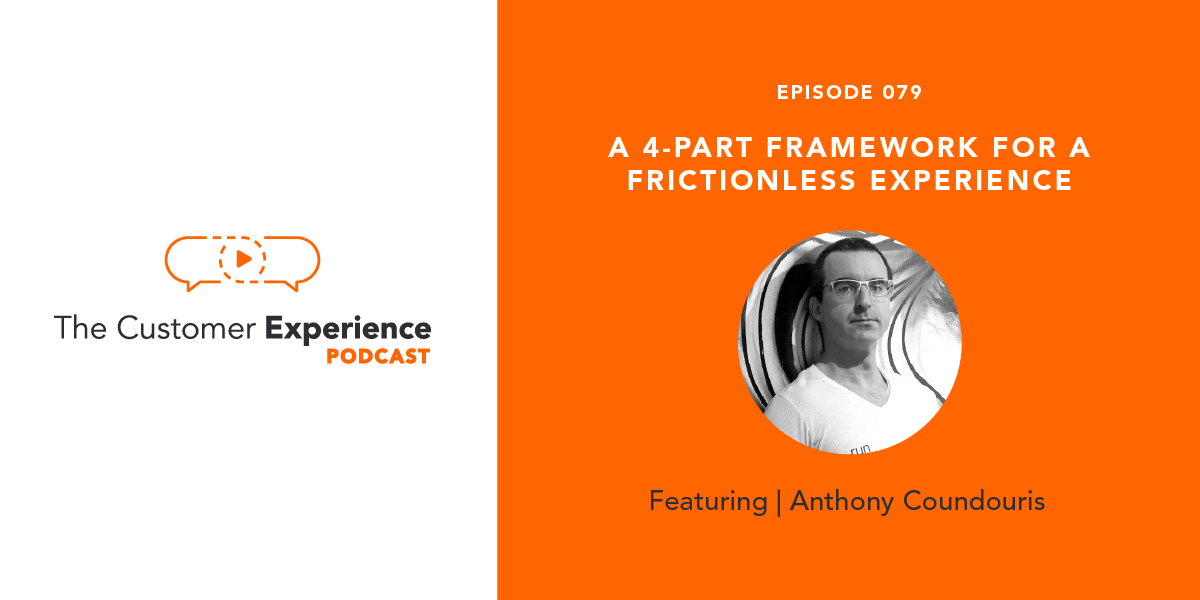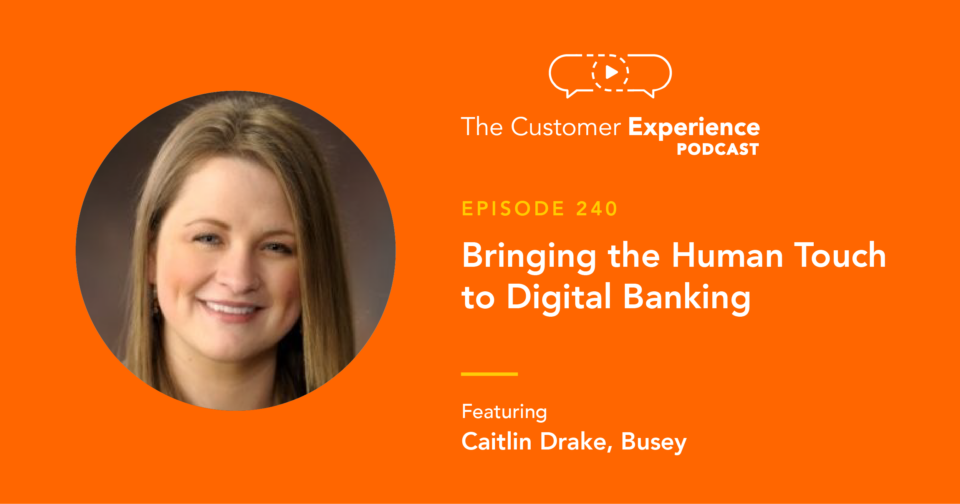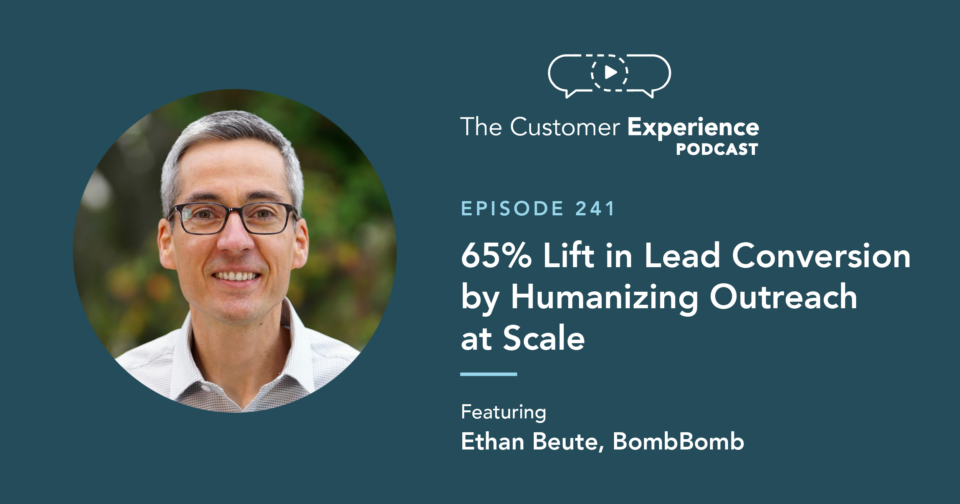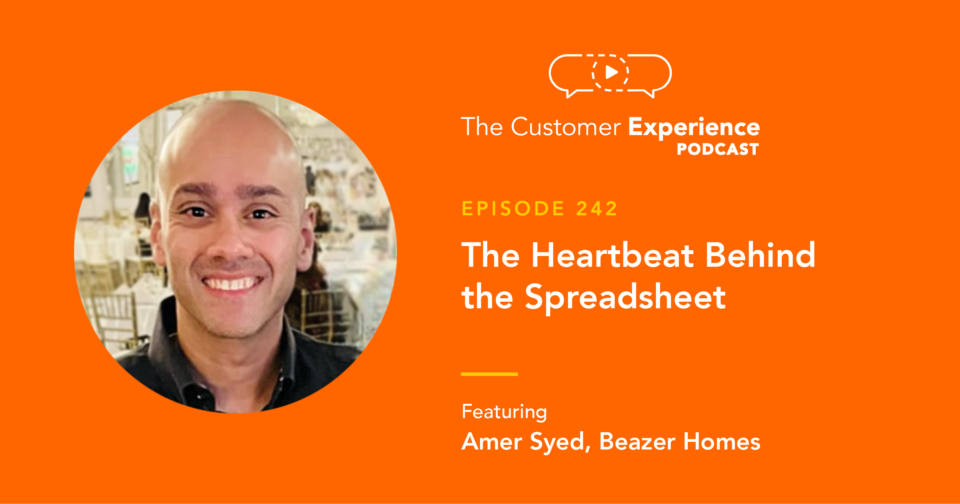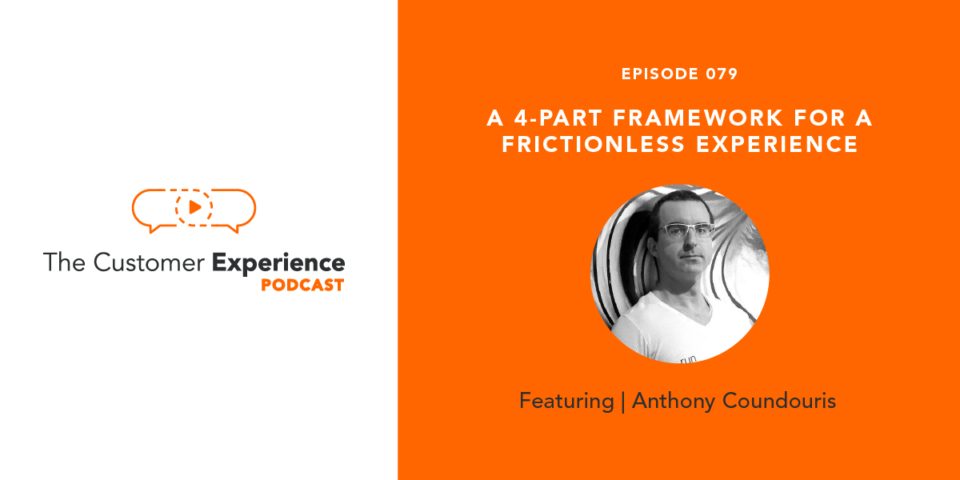
Listen to “79. A 4-Part Framework for a Frictionless Experience w/ Anthony Coundouris” on Spreaker.
Apple Podcasts | Google Podcasts | Stitcher | Spotify
Ever wonder why your customers aren’t having a faster, smoother, or more appropriate journey with your company? If so, it could be due to friction in your business that’s slowing down or even ruining your customer experience.
For example: when you survey your sales team, does everyone agree on what they’re selling? In many situations, the answer is shockingly, no. This causes friction.
And it’s usually the result of customer experience being seen as an afterthought, rather than something designed in. So, unless you’ve intentionally built it into your organization’s core foundation, you probably aren’t offering a frictionless experience.
But help is here.
Today’s guest on The Customer Experience Podcast, Anthony Coundouris, shares a framework for reducing friction for customers by aligning four quadrants.
- Q1: Who we serve
- Q2: What we serve
- Q3: Who we are
- Q4: How we serve
Anthony is the founder of run_frictionless, a consultancy that helps companies achieve predictable sales. He also authored “run_frictionless,” which delves into the quadrants and how they shape customer experience.
Throughout our conversation, we discuss:
• How to reduce friction by designing to and operating from the four quadrants
• How to avoid selling to the wrong person
• How to ensure that everyone is selling the same product
• Why belief must be shared from inside out
• How those shared beliefs insulate your sales and trigger irrational buying forces
• Why you should ignore competitors and focus instead on customer expiry
A 4-Part Framework for a Frictionless Experience
Hear the entire conversation with Anthony Coundouris on the four quadrants and a frictionless experience right here:
Listen to “79. A 4-Part Framework for a Frictionless Experience w/ Anthony Coundouris” on Spreaker.
Hear this episode and any of the others by subscribing to The Customer Experience Podcast in:
While you’re there, please take a minute to rate and review the show – it’s very helpful to the show!
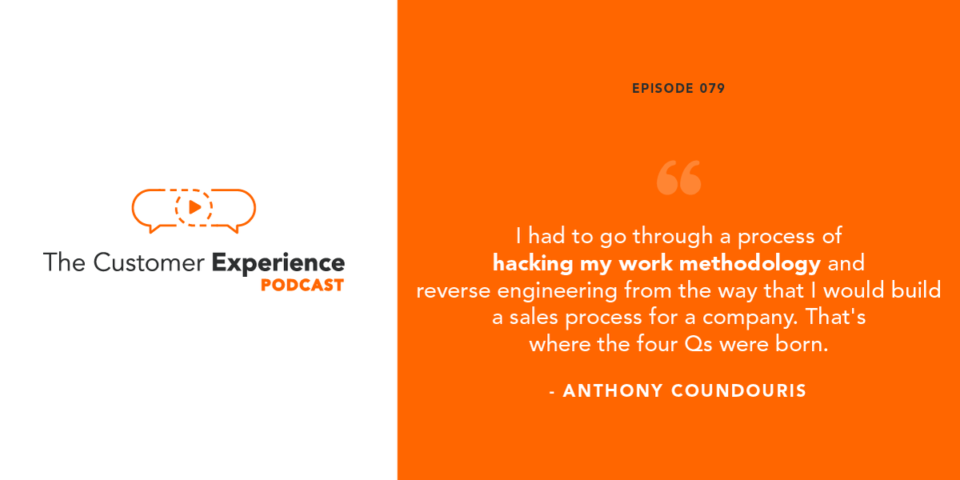
Full Transcript: A 4-Part Framework for a Frictionless Customer Experience
Anthony Coundouris:
Thanks very much, Ethan, for having me here.
Ethan Beute:
Yeah. I’m excited for the conversation. I really enjoyed the read and I’m looking forward to getting into the four quadrants. So the conversation is going to be kind of organized the way that you organize the book, which I’m sure is the way you organize some of your consulting engagements. But before we get going, you’re from Australia and you’ve worked extensively in Southeast Asia. Where are you right now? And what’s the coronavirus situation for you?
Anthony Coundouris:
Yeah, I was working on some projects in Vietnam when the bad news was announced and we evacuated immediately and hit a small little town in Thailand in the South near the border of Malaysia. And that’s where I’m hold up at the moment. I’m living in a very rural existence and the water I’m drinking today it’s from a well, and the food I ate this evening was from our garden.
Ethan Beute:
Wow. What an interesting situation. Are you there? What’s the setup for you?
Anthony Coundouris:
Well, we just didn’t think we could trust the Vietnamese government to tell us the truth about what was happening with the virus. As soon as it was announced, we left and we headed back to my lady’s hometown. It’s a place called …She decides to… No one knows it. It’s not a tourist destination. And that’s why we haven’t had a single case of the coronavirus, but we’re like you, we’re locked down. No one’s allowed to go to the offices. Coffee shops are all closed. Gyms are closed. It’s bored at home, right?
Ethan Beute:
Yeah. Well, I appreciate you making time for me and I’m glad you found a nice quiet, safe spot. And it’s probably a really, my assumption and hope for you is that you’ll look back several years from now and be appreciative for this unique experience.
Anthony Coundouris:
Yeah. I think one of the things that a lot of my friends have commented on is how much quality time this has given with their families. Perhaps it sorts of doing the same for me, till Ethan.
Ethan Beute:
Yeah. Good for you. So let’s get started properly. I always like to start with your thoughts around customer experience. When I say customer experience, what does that mean to you, Anthony?
Anthony Coundouris:
Well, I used to think that customer experience was something that was very divorced from sales, that it was just something that was tacked onto the end. Like you sort of build a business and then everyone says, Oh my God, we need a customer experience, right?
Ethan Beute:
Yes.
Anthony Coundouris:
So they get on and sort of add it, right. Oh, we’ve got it now. Good. So glad have that covered. And I used to think like that, like so many people, and then what we began to realize our research team is there’s a strong correlation between sales and predictable revenue and customer experience. That is the more improvement you can make in the way that you deliver a service or a product or a customer, the more likely they are to buy product. And hence the reason why it can improve sales.
Ethan Beute:
Awesome. I agree. It is obviously not attack on, it needs to be designed from step one and it’s an integrated thing. And frankly, that’s why we’re doing the show is to figure out how to make sure we can connect leadership and strategy and decision-making at a high level with sales, marketing, CS, and all of the other teams and functions that are responsible for creating and delivering the experience because the experience starts sometimes before you even have a customer. And so as does your book. So before we get into it, when did you decide to organize your thoughts into run_frictionless and how did that go for you? What was the writing process like?
Anthony Coundouris:
Oh, it was horrendous because I had no production methodology because I am a first-time author. I’ve never written a book before. And so I just, I told myself that I can do this in six months and no, it took longer. So I had to go through a process of hacking my work methodology and reverse engineering from the way that I would build a sales process for a company into something that was digestible in 150 pages. And that’s where the 4Qs was born. The 4Qs didn’t exist before that. I just did it unconsciously, but I found it so difficult to explain it to people until I sat down and said, okay, I’m going to put pen to paper. How do I explain this in a rational way that makes sense?
Ethan Beute:
Excellent. Good thinking is good writing and good writing is good thinking. So I’m glad you went through the process. I found it highly digestible. Before we dive into each of them, can you just give us an overview of the four quadrants and I’ll just read them off really quickly? Q1 is who we serve. Q2 is what we serve. Q3 is who we are and Q4 is how we serve. Can you just give an overview of those and kind of how they relate to one another?
Anthony Coundouris:
Yeah. Sure, Ethan. So the 4Qs framework is a decision-making framework. And in a sense, what I sort of realized was is that sales is not the responsibility of salespeople. It’s an organizational goal. And what you quickly find is with the 4Qs is that it recognizes and pulls together the entire organization to get behind the salespeople. So the salespeople become just the tip of the iceberg. If I was just to give you a quick overview of say what each of those quadrants are, quadrant one, who we serve, it really focuses on customer profiles. Quadrant two, what we serve is what you’re serving to quadrant one that tends to be a product or a service in most situations.
Anthony Coundouris:
And quadrant three, which is who we are, is really ubiquitous. Unlike say quadrant one and quadrant two, where you can get a fit between quadrant one and quadrant two, quadrant three is about our beliefs and the corporate identity. And it works across all of the three quadrants. And the last one of course is probably one of your favorites quadrant four, which is how we serve, which focuses on precisely what are the interactions required to create a customer.
Ethan Beute:
So let’s get a little bit into Q1, who we serve. Again, it’s the customer, it’s persona, it’s the ICP quadrant. Maybe provide one or two takeaways for people here.
Anthony Coundouris:
Yeah, sure. You know, one of the most interesting things about quadrant one is how so few organizations, when I walk into talks to them about what it is that they, who they serve, they essentially just give me a very generic explanation. We just serve enterprise, or we serve small business owners. I’ve even heard a CEO say to me, we just serve anyone. Well, anyone who buys. Okay?
Ethan Beute:
Right.
Anthony Coundouris:
And I laugh because in the back of my mind is I’ve never met this person called anyone. Right. I’ve met Tom and Sally and Harry, but I’ve never met this person called anyway. It’s just this awesome person who just buys everything. It’s just amazing.
Ethan Beute:
Yeah. Or this person who introduces herself or himself as the enterprise.
Anthony Coundouris:
Yes, like there’s such a decision like you’re… One of things that I think a lot of organizations can do is spend a lot more time, first of all, just trying to analyze and think about who they are serving and not just talking about age and demographics and all that sort of stuff, but looking more at really discernible, significant data points like perhaps their maturity or their sophistication, and looking at asymmetrical ways of measuring that, that maybe their competitors are not using.
Ethan Beute:
It’s really interesting. One of the things I really enjoyed about Q1 was the discipline of it. And I’m going to read you one of your quotes from your own chapter and maybe give me a response to it. And I’ve got one of these for each of the quadrants, by the way. “The customer profile is a mutual understanding between the sales force and customer service about who is allowed to become a customer.”
Anthony Coundouris:
Yeah. Because you know, when you’re scaling up and you’re trying to free yourself of the sales problem as a founder, if you start paying sales commissions to any profile that a salesperson brings you, well, of course, that’s exactly what they’ll do. They’ll bring you anybody. And I started to see like in some organizations where with certain customers, we would succeed. We’d have success for say transaction +60 days, and then many other profiles in which case the success rate was very, very low. And what you start to figure out is, is that really the product yes, technically could serve a lot of profiles, but really you know that there’s only one or two that perhaps it’s really optimized for to work well.
Anthony Coundouris:
You know, like one of the questions I always ask the salespeople is, the sales managers is like, look, if you serve this profile, whoever it might be, will you get a positive review? It doesn’t necessarily mean that they’re going to write something positive, but they might say something positive. And if you know in your heart they’re not going to give you a positive review, for goodness sakes don’t serve them.
Ethan Beute:
Right. Just because you can close it doesn’t mean that you should, because to your point here, if you can’t see retention, potentially expansion, positive reviews, positive word of mouth, referrals, etc, you’re probably doing a disservice to both you and to the customer.
Anthony Coundouris:
Yeah. Because you know there’s someone out there right now who really needs your services. And if you’re squandering your time serving customers who are never going to give you a positive review, who are going to hassle you for refund, who are going to give you the wrong intelligence to drive quadrant two, why are you doing this when there’s customers right now who really need your organization, they need your sales team? They’re the ones you have to focus on.
Ethan Beute:
Yeah. So who we serve obviously critically matters. Let’s move to quadrant two and that is the what we serve, the product in the feature quadrant. Obviously, this one’s closely related to Q1, but maybe share a couple of big ideas in the second quadrant.
Anthony Coundouris:
Yeah. One of the big takeaways I’ve had in quadrant two is when I talk to CEOs and sales leaders in organizations, one of the things I asked them is what are you selling? What do you serve to quadrant one? And what I mean by that is could you describe the features and the benefits? So I’ll write this down and then what I’ll then do is, is perhaps do a friction test where I’ll interrogate their online chat, their telephony people, the people who answer their email, and then I’ll compare the results of what people are selling and telling me. And inevitably what we find is really inconsistent and wild differences day-to-day, and from organization to organization about what we sell, even though I’m told nine times out of 10, we know exactly what we’re selling. We know what the product is.
Ethan Beute:
Yeah. So that disconnect is obviously a highly, highly problematic. One of my favorite things in this section was, especially, I think this is super relevant to software. I think most people can relate to it, but I’m sure it relates to a variety of other businesses as well. But I’ll quote you and then kind of talk about some of the problems that fall out of it. And then I’d love like what drove you to include this. And it is to avoid future sell because it introduces friction. It leads customer expectations. You wind up creating bespoke software. People can now defer the buying decision because you’re promising something that’s going to be built or delivered in the future. It makes the sale conditional in a way like I’ll buy it if or when, and it undervalues what you currently offer it, it undervalues what you serve today.
Anthony Coundouris:
Yeah. Because so often the reason that the organization contacted you to start the conversation, they actually forget the benefits, allowing even the sales team actually going back and reiterating those really important features, which are in the product right now. That reinforcing those and reminding the organization, this is why you should buy us. They’ll essentially open up their order book and start to take down what needs to be in the product. So the customer is like, let’s build this in real-time together. Manufacturing companies got this right such a long time ago, like they stamp everything. They talk about the limitations of their products every time that they send out information. They ship things with explaining to you, not just what it does, but they say with unequivocably what it doesn’t do, which is part of the education to the customer.
Anthony Coundouris:
And coming back to what you were saying before about future sale, I’m sure you’ve seen it yourself, Ethan. I know you’ve done consulting before. It’s where, if you’re in the early stages of a startup, it’s not so bad because the consequences are very, very low. But imagine for a moment you’re now a scale-up, you’re adding shareholders, customers, staff, people keep hearing and mixing sales messages with the vision of the company, as opposed to what’s coming in a couple of months. Pretty soon now everybody believes what’s in the future is what they’re selling right now. And that’s when these problems or these conditional moving targets begin where customer says, hang on a moment. You promised that it would be there, it’s not. I’m not going to buy it. Go and build it.
Ethan Beute:
Future stuff can happen because of a variety of problems. One of the worst though is when it’s kind of made up on the spot in order to address a sale that’s imminent, right? That may or may not be the right person. And it’s definitely not the product that you have today is that you’re promising on the spot something just to kind of keep the conversation going.
Anthony Coundouris:
Yeah. I mean, legitimately though, the discipline I try to introduce in organizations that say, look, the product people are the only ones who are allowed to write those product fact sheets, and then the marketing and the salespeople can then draw on that. And the roadmap, which details what’s coming in future quarters I say to the organization, it should be absolutely locked away and not talked about because the problem is, is that we suffer a bias where you might just hear around the water cooler a feature which is being released, the sales people, whoever is listening to that will interpret that as being in the present tense, not in the future. And we’ll go out and sell it in the present tense.
Ethan Beute:
Yeah. And to your point too, and then we’ll move on. But to your point, you know it undervalues what you have today. It’s so interesting. I’ve been at BombBomb for over eight and a half years. And so I’m deep in and it’s easy to take for granted some of the most basic features, benefits, opportunities, use cases that people are getting massive, massive value out of. And you just stay focused on what’s new, what’s hot. What’s fun to talk about. What’s this thing we’ve been thinking about or planning for months or for years and now it’s finally about to come to pass. And so there’s this constant future orientation and undervaluing even internally of how you can benefit people.
Anthony Coundouris:
Yeah, yeah. No, good point. It’s really a discipline if anything. But one of the things I talk about in the book is just sell what’s in the warehouse, and I try to bring it back to the way manufacturing companies say. They’re really brutal. You know, they like, “Listen, man, it’s in black and it’s in red. You want it or not?” And sometimes I just wish people selling software could be as brutal. And actually, they probably would get the order just by being so confident.
Ethan Beute:
I thought you were going to say black or white, but black and red. The point’s the same. It’s like, this is what we have. Would you like to buy it? Awesome. So I like Q3 and Q4. Actually, I like all of it. I like the framework. That’s why we’re having this conversation. But Q3 in particular is really, really interesting. It’s who we are, kind of the brand quadrant. And so share a little bit, share maybe the top two or three things that you really find to be problematic or exciting or interesting as you’re consulting people around the themes in who we are.
Anthony Coundouris:
So I think that a lot of organizations today have realized that customers buy rationally from quadrant one out of quadrant two, hence the quadrant one-quadrant two fit. So they’ll look at the features, they’ll look of the limitations. They think about the workarounds and they compare different vendors and they try to come to a rational decision, right? Now here’s an interesting play though. Quadrant three is about who we are. In particular, one of the levels that it operates on is around this idea of beliefs, which is based on cultural identity. So our team did a lot of understanding about cultural identification and the way in which we operate as tribes and the sense of belonging that we have, right? Here’s something interesting. Some of the research that we’ve done suggests that 70% of buying decisions is not out of quadrant two but out of quadrant three. So quadrant three, you know you struct a quadrant one-quadrant three fit if you hear this from a customer. I’ve been telling people this for years. Finally, somebody has built the product that I’ve been talking about. Thank you so much for listening to me.
Ethan Beute:
So 70% of buying decisions are made out of quadrant three, which is this idea of shared beliefs. I’m going to read one of my favorite sections in the book, “Sharing beliefs sets in motion a set of irrational buying forces that are near impossible for a competitor to mimic. The irrational buying force is so strong that even when sales, product and operations people are screwing up, customers keep buying because they believe in the brand.” I love this idea, two ideas in particular, and they’re obviously interrelated. The shared belief, like the way we see the world as a team and as a company is the same way that our customers see the world potentially.
Ethan Beute:
And so this is this kind of shared belief in this identity piece, and then this irrational buying force, which is what I think you were talking about in that setup, which is, it’s not a Q1 or a Q2 decision. It’s not this rational decision, but there are irrational buying forces that I think speaks to, I guess, at a high level, kind of the dual theory of the mind, the idea that we make our decisions emotionally, and then we back ourselves up rationally. And so talk a little bit about this interplay of irrational buying forces and shared beliefs. And maybe even to that second line that I quoted there, the grace that we’re given by our customers, even when we’re screwing up because they believe.
Anthony Coundouris:
Yeah. Okay, thanks, Ethan. You know, quadrants one and two are not very defensible. I’ve had arguments with CEOs about FAQs. They don’t want to put up FAQs because they know that competitors reverse engineer back out of FAQs in terms and conditions to figure out even how the product was built. We know quadrant two is not defensible. And yet so much emphasis is put on product. Like when people are talking about, I want to increase my price. I say, just add more features. Of course that’s not the case because the customer doesn’t know the product is any better because they haven’t bought the product yet. And what retail has told us a long time ago, they said, look, all you need to do is just emphasize a little bit more around your packaging, which happens to be a buying cue to quadrant two. So quadrant three is a buying cue to the quality that’s coming in quadrant two. And then this concept of shared beliefs is rather interesting. We saw a really recent example. Do you remember the launch of the Tesla truck and what happened during the product launch, right?
Ethan Beute:
Right. The shattered window.
Anthony Coundouris:
Right. So Elon shatters the window. So you could say, well, and in fact, the automotive journalists did, they said, “Hey, bad product day. Bad quadrant today.” This is an example of one of these startups, bad products we really shouldn’t be listening to them. Yet, despite that at the close of business the following day, Tesla post a press release saying they received over 100,000 orders of the truck. And I just watched this video and saying, this is going to be not a demonstration of a bad product day, but what it means to have a shared belief with a customer. They weren’t buying at quadrant two. They had completely forgave him. Like, you know what, man, we get all that. Because every company has a bad product day, and the difference is will they crucify you or will they forgive you?
Ethan Beute:
It speaks again to that irrationality. And I also like that you started with something that I had overlooked or failed to mention, which is this, this is the defensible part of the business.
Anthony Coundouris:
Let’s not underestimate how hard it is to achieve a belief. Look, Ethan, you and I can have a belief that no one else shares. And we’re call crazy people and they lock us up. Right. We’re delivered to the asylum and then that’s where we stay there. But there are other people who resonate, right, and become leaders. And then because people are listening to them like, Hey man, I get this. I know what you’re saying. I feel the same way about this. I’m going to join and we’re going to have a quadrant one-quadrant three fit here. And if you can get that kind of fit going in your organization, it’s so difficult to mimic because it’s inside out.
Anthony Coundouris:
You see, you have to hire the same people who believe in the same thing, because otherwise, as soon as the customer pierces your organization and gets past the marketing veneer and dig into your business, they’re going to find those people who don’t believe, and then they’re going to get you, Ethan. They’re going to say, hang on, you sold me on a belief and you’re the only guy in the company that believes that and the rest of you don’t. And I feel really deceived
Ethan Beute:
Yeah. And the sad or scary or potentially harmful aspect of that is that you might not even say that consciously as a customer, you just feel this disconnect and you feel this distrust and you can’t necessarily articulate it, but you’re like this isn’t what I thought this was. These people aren’t who I thought they were. This isn’t what I was expecting or hoping for. And you might not even say those things consciously, you just kind of like, from the company perspective, you swipe the credit card once and then you just kind of disappear.
Anthony Coundouris:
Yeah. Because it’s not from quadrant two, they can’t put their finger on. They can’t say it was a feature or you lied about a limitation. It’s really hot. You’re quite right. You probably wouldn’t even see it in an effect, like a feedback form somebody replying back about. They just wouldn’t know how to articulate this, but, boy, do they feel it in their heart.
Ethan Beute:
Right. And again, this is the dark side of the irrational buying force. This is the irrational quitting force or similar, whatever. It’s the flip side of that. So Q4 is how we serve. It really is the customer experience quadrant. So what are a couple things folks should take away from how we serve?
Anthony Coundouris:
First of all, let’s make sure we have the definitive number of interactions that are required to create a customer. So our research showed us that if you’re serving small business owners, you’re talking between sort of 10 to 15 interactions. And if you’re serving decision-makers from enterprise companies, you’re supporting 25 upwards of say 50 interactions. And now what you can really start to do when you do a quadrant one-quadrant four fit is you can start to really look at the cost of service. You can say, well, that’s a $50 interactions, that’s a 25 US interaction. Start adding them up and you start to see really what it costs to serve that customer.
Anthony Coundouris:
So that’s, I think probably one takeaway, but Ethan, he’s another one that kind of data point that I think that a lot of the readers or listeners today, perhaps not tracking in quadrant one, they ought to be. And I think we’ve probably come to it in a moment. That’s that one called customer expiry. It’s a really interesting data point. And let me explain how we came about it, how we fumbled upon it. So it happened in 2015, we were asked by a CEO of SaaS startup to find out why is it that our prospects are walking out away from our pipelines to our competitors. So what we looked at was we looked at about six months worth of data. And we go to our research team to call these individuals to say, okay, what happened during your prospecting stage? Interesting figure, 15% of them didn’t buy anything. And yet we confirmed that they are legitimate buyers by checking their profile on LinkedIn.
Anthony Coundouris:
We get back to the CEO and said, “Well, I don’t know if it’s a competitive problem because 50% did nothing. They didn’t buy.” And he said, “Well, could you go and find out why?” And we did. And so we probe deeper, did some telephony survey. Turns out these customers actually think the whole industry suck. They think it’s so much friction in order for them to make a buying decision. They would rather suck eggs, continue using Excel and never hear about these organizations again. And we were able to figure out a number just by the questions that we asked them. And it turns out that this group had assigned consciously or unconsciously between 14 to 18 days in which they had to make a buying decision in their organization. So when we went back to the CEO we said, “Well, do you know when you decide to redesign quadrant four, actually, you don’t need to worry about your competitors. You just focus on one data point called customer expiring. For goodness sakes, develop a customer experience that can be delivered in 14 days. And you’ll probably make a lot of money.”
Ethan Beute:
Interesting. So just go a little bit more at this 14 to 18 days, what needs to happen in that window?
Anthony Coundouris:
Okay. So the number really will change from like whoever’s listening to your podcast, right?
Ethan Beute:
Sure.
Anthony Coundouris:
It’s going to be different. We’re seeing buying decisions happen as short as seven minutes, all the way to six months. Right? And it just happens to be that example was 14 days. That is the early, the middle and the end game, all has to be closed out. But it doesn’t mean rushing or forcing or ramming the customer, but those set of interactions, those 15 interactions or those 25 interactions all still need to be legitimately delivered within 14, 15, or 18 days.
Anthony Coundouris:
So that means you need to start getting pretty creative about how you serve those interactions. What will be automated, what will be human. What are going to be the different objectives because you better make sure that every interaction actually does something because there’s no time for wasting that you’re having a little conversation on the side of the road. Just a little pep talk, shall we, about your dog and just catch up on that. No, no, there’s no time for that. Because they’ve got 14 days and they’re going to run away. They’re not going to buy it from anybody.
Ethan Beute:
Essentially the clock is running.
Anthony Coundouris:
Yeah. It’s a race as you put it to me earlier, it really is. It really is a race. It’s the best way to think about it.
Ethan Beute:
Well, and that’s the quote that I pulled out of Q4, which is, “Think about achieving the customer’s goal as a race.” And the reason I liked that so much is that it speaks to a theme that I’ve been thinking about and talking about and hearing more, like the more you pay attention to something, the more often you see it. And it’s this idea of owning the customer’s outcome, not just as a desired outcome delivered via an appropriate experience, but really owning the customer’s metrics as if they’re your own and really becoming a partner in their success. And then of course, there’s the race component on top of that. And do it within the expiry window.
Anthony Coundouris:
Yeah. I remember talking to a bunch of payments companies in Southeast Asia and they thought the customer’s goal or the customer’s outcome was to pass the KYC or the verification process and open up an account to do a cross-border payment. After we got through talking to them, customers said, actually, we don’t care about that. We want to make a transfer today. That’s my goal. So if I say that I’ve got 14 days to make a buying decision, right. It’s not necessarily the goal that you think. It could be something way more elaborate or the outcome could be a different kind of metric than we first thought it was.
Ethan Beute:
Yeah. It’s not the acquisition of the product or the service itself and the transaction. It’s obviously, I mean, that is one of your necessary checkpoints on the route to whatever is sought the customer’s goal.
Anthony Coundouris:
Yeah.
Ethan Beute:
Any other high-level observations here about the quadrants? Obviously, it sounds like you develop them as a consequence of organizing some of your thoughts and your experience for the benefit of, again, we should have mentioned the subtitle is that it’s, Freeing a Founder From a Sales Role, but you also did a nice job in the book of speaking to early-stage and more developed businesses, and at the end of each chapter with the important takeaways. Is there anything we didn’t cover here that you find is either very interesting or provocative or relevant or necessary for the types of companies that you’re working with?
Anthony Coundouris:
When I wrote the 4Qs, look, one of my, I suppose, criticisms of frameworks is how stupid they make the reader. They’re like project management tools, assess, do it, results. Oh wow. You know, that’s a framework. Okay. Well, that’s way too simplistic and it doesn’t allow any creativity. So the 4Qs is rather different. For instance, Ethan, we could start in quadrant two to reduce friction as opposed to moving. You don’t have to move sequentially from one, two, three, or four. A lot of people start in three, like around beliefs. So first of all, there’s no starting position. And the thing that I also like about it is it’s a little bit like a woodworking project. Now let’s just say we’re building a table together. Well, to get the various components to fit, sometimes you need to shave off a little bit here and saw a bit more of that piece in a sense you’re getting a fit. And Andreessen would call, he sort of used this word product-market fit.
Anthony Coundouris:
You can use the quadrants the same way. For example, we talked about quadrant three-quadrant four fit. So you develop the belief, then you wrap those words and pictures from quadrant three around each of those interactions which you designed in quadrant four. But he’s another interesting play. What about a quadrant one-two-four fit? So a lot of times salespeople don’t know what to sell next. So I think one of the plays of quadrant four is to intelligently sell the next product from quadrant two to the right person in quadrant one, hence a quadrant one-quadrant two-four fit. You can try and get a fit of one to four by saying, well, we can design individual very unique customer experiences for each of our profiles in quadrant one. A lot of us are doing that now. We’re realizing that you can’t have generic experiences in quadrant four anymore, but also we can start to intelligently sell product in quadrant two by applying the same theory.
Ethan Beute:
Really good. So do you, when you engage with a company, do you tend to lead with this book so that you have the same language to start with? Or does it kind of come around?
Anthony Coundouris:
Yeah, it’s interesting. One of the feedback that I’ve been given by the users, the readers of the book is it creates, if anything, it creates a common vocabulary where it doesn’t really matter whether you’re the product guy, product girl, the CEO or somebody who’s delivering the CX in quadrant four. It’s really easy for guys and girls to get together and make a decision. So I like to not make the book a barrier. I don’t want to introduce friction into my own sales process. So what I do is I give them like a one-hour quick overview, teach them the power of the 4Qs and just get them using the vocabulary. And it seems like I start using it in their organizations like the line managers. And pretty soon the people within the various functions of the group start using the same words, which makes it easier then to make the changes that we need to later.
Ethan Beute:
Yeah, really good. So if you are listening to this episode and you’ve enjoyed it, A, of course I recommend run_frictionless from Anthony. It’s a really good read. And I’ll also recommend two other episodes of this show, episode 25 with Brian Gilman, who is the Vice President of Solutions Marketing at Vonage. That episode is called Why Friction is a Customer Experience Killer. And it’s a lot about solutions marketing. And then episode six with my longtime friend, team member, co-author on Rehumanize Your Business. And he is the CMO at BombBomb. That episode is with Steve Pacinelli, and we titled it Connecting with Customers by Exploring a Shared Belief. We had a shared belief conversation back on episode six. And I think this is going to be episode 70-something. I forget where we are.
Anthony Coundouris:
It’s amazing.
Ethan Beute:
Yeah, it’s really good. So this has been awesome, Anthony. I really appreciate it. Before I let you go, though, I always like to give you the chance to thank or mention someone who has had a positive impact on your life or on your career.
Anthony Coundouris:
Yeah, I’d say Andy Walsh. He was the former Creative Director at Wunderman in Sydney. Andy, he’s one of these beautiful managers where even under the stress of a corporate environment, it’s still a really human experience working with him. And we’re delivering really big goals, but he’s not making a big fuss about it. He’s from the United Kingdom. He’s a very gifted creative director. And when I was an upcoming art director, I’d sit with him at 7:00 AM in the morning, getting him a coffee, myself a coffee, open up our laptops and start working together. And it was just fascinating listening to him talk and help us to put together the next piece of work that we’d be doing for a telco or something.
Ethan Beute:
So good. What a great story. And now how about a company that you really respect for the way that they deliver for you as a customer?
Anthony Coundouris:
LEGO.
Ethan Beute:
Beautiful.
Anthony Coundouris:
Nice, definitely. I think LEGO, they’re just, they understand productivity orientation without being ridiculous. They’ve got such a good hold on the firm grip on quadrant two and the way it permeates the whole business. It’s beautiful their product. I mean, even as a young boy using their product before I really understood anything about quality. It felt like quality when I used to sit down and play with other kids. We’d get around and share our LEGO sets and then it was all about the creativity, what you could do with them. I really feel like as an adult, it’s somehow had a really positive impact on me as a youngster leading into my adult life. I think it’s done something really good for me, their products.
Ethan Beute:
Yeah. I completely agree. And just to the quality piece of it, I had a similar experience. And my brother and I, I have a brother who’s two years older than me, we had a lot of LEGOs and a lot of LEGO sets, but eventually what wound up happening was that they all wound up in one box. And so the sets kind of have some outer space stuff with like some trees and other things all in one big box and the state of my parents’ home. And when my wife and I had our son, I got them back out and I just went through all of it again. All of the products are still perfectly intact. They don’t break and they all work with all of my son’s new sets.
Ethan Beute:
So of course, one of the ways that they’ve gone to market is they’ve done licensing deals with a bunch of really popular brands and things. And so I think my son had some Star Wars stuff, some Harry Potter stuff, LEGO sets, but they all still work. Like you can still start the construction of something new that doesn’t exist in a step-by-step guide on how to build it and all the pieces all work together. And they’re still in wonderful quality.
Ethan Beute:
This has been so fun, Anthony. I really appreciate it. I really like the work that you do and the way you approach it. I’m glad that you went through the experience of writing in order to A, organize these thoughts, but then B, allow them to be easily shared with people. I assume if someone’s listening at this point, they’ve enjoyed our conversation and may want to follow up with you. Where would you send people if they wanted to learn more about you, the work that you do about run_frictionless as a consultancy or run_frictionless as a book?
Anthony Coundouris:
Yeah, I think probably the URL runfrictionless.com, just one word. That’s an easy place. Or just check me up on LinkedIn. If you want to post a link there to my LinkedIn account, or you just want to connect with me, start with hello. It would be great to share some ideas and some stories together.
Ethan Beute:
Super. I will do. For folks listening, I do put up write-ups of these video clips, a fully embedded audio and more at bombbomb.com/podcast. That’s bombbomb.com/podcast. And so if you want to connect with Anthony on LinkedIn, or if you want to check out the book or you want to check out the website, all that will be linked up there at bombbomb.com/podcast. Anthony, thank you again so much. And thank you for listening.
Anthony Coundouris:
Thanks very much, Ethan, for your time and for being so patient with me to organize our session together. I have thoroughly enjoyed this, Ethan. You’re a very prepared host. I really enjoyed the session. Thank you, fellow.
Ethan Beute:
Sure. Thank you. And I’m glad again, you found a really beautiful and safe spot for this time period.
Anthony Coundouris:
Right there, Mister. Take care. I’ll stay in touch with you. Thank you very much.
Ethan Beute:
Sounds good.
Anthony Coundouris:
Bye-bye.
Video Highlights: A 4-Part Framework for a Frictionless Experience
Check out the top five video highlights from the discussion with Anthony below…
1. The Four Quadrants and Frictionless Experience
2. Avoid Selling to the Wrong Person (Q1)
3. Are We Selling Same Product? (Q2)
4. Shared Belief Must Come Inside Out (Q3)
5. Customer Expiry Considerations (Q4)
More with Anthony and run_frictionless:
- Anthony Coundouris (LinkedIn)
- run_frictionless (consultancy)
- run_frictionless (book)
- run_frictionless (quick, interactive overview)
Other Episodes You’ll Enjoy:
- “Connecting with Customers by Exploring a Shared Belief” with Steve Pacinelli (CMO at BombBomb)
- “Training and Certifying Your Sales Team to Speak Your Customer’s Language” with Alex Rosemblat (VP of Marketing, Datadog)
- ““Why Friction Is A Customer Experience Killer” with Brian Gilman (VP of Product and Solutions Marketing, Vonage)
Please Subscribe To and Rate The Customer Experience Podcast:
